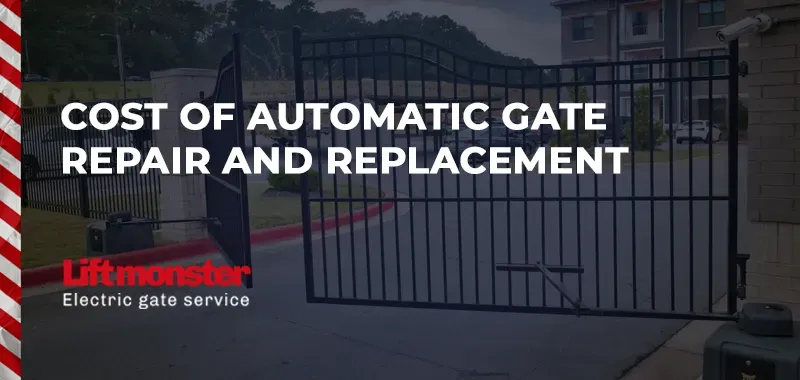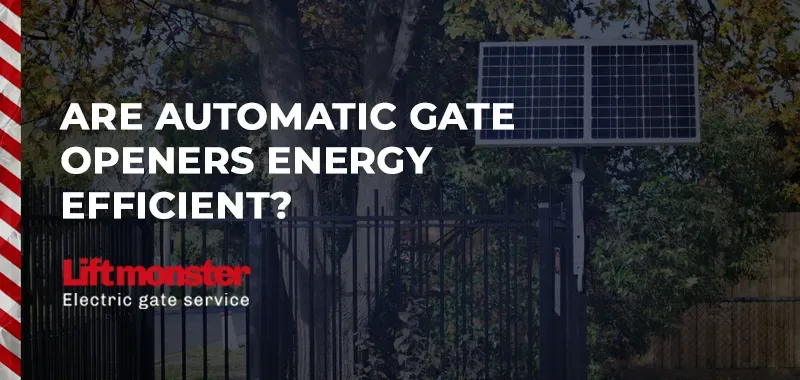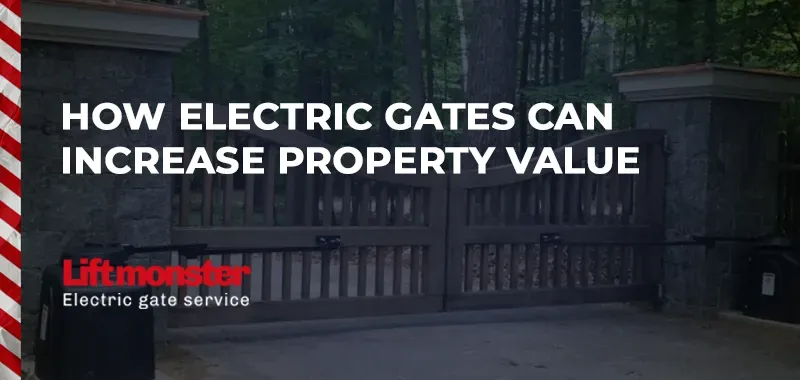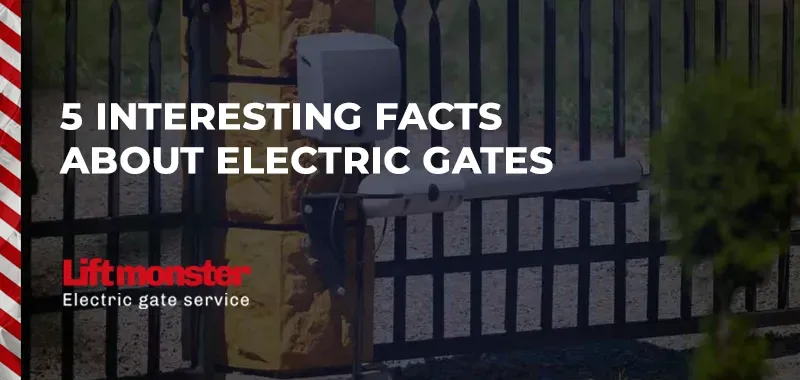Slide Gate or Swing Gate: Which Is Best for My Driveway?
Choosing a driveway gate might sound like a simple decision, but if you've started your research, you already know—it’s anything but. Between swing gates and slide gates, you’ll find yourself weighing everything from aesthetics and space to slope, security, and even your local weather patterns. The choice isn’t just about what looks good from the street. It’s about what works for your home, your lifestyle, and your long-term needs. For professional gate services, Lift Monster is here to help!
What Are The Benefits Of Installing An Automated Gate?
Understanding the Basics: How Each Gate Works
Before diving into comparisons, it helps to understand how these two gate types operate.
A swing gate opens just like a door. It swings inward (or occasionally outward) on hinges, usually as one large panel or two symmetrical halves. Think of it as the classic look—elegant, traditional, and stately.
A slide gate, on the other hand, opens by sliding horizontally along a track or rail. It tucks neatly to the side of the entrance, making it ideal for narrow or uphill driveways.
Both gates serve the same purpose—security and access control—but they do it in very different ways. And that difference affects everything from space to safety to maintenance.
Space Considerations: How Much Room Do You Really Have?
One of the most important factors in gate selection is space. Swing gates require a large clear area in front or behind the gate to open fully. If your driveway is short or your house is close to the gate line, this could be a deal-breaker. A double swing gate might need up to 10–15 feet of clearance depending on its size.
Slide gates, by contrast, only need horizontal space along your fence line. They don’t eat into your driveway space at all. So if you have limited depth but plenty of side room, sliding gates offer a sleek, space-saving solution.
Imagine a scenario: Your driveway backs up directly to a busy sidewalk. A swinging gate that opens outward would not only be unsafe but likely illegal in many places. In this case, a sliding gate wouldn’t just be convenient—it’d be your only real option.
Automated Gates VS. Manual Gates: A Comparative Analysis
Dealing with Slopes: Why the Ground Beneath Your Gate Matters
If your driveway is on an incline, the type of gate you choose could make or break your setup. Swing gates don’t do well on steep slopes. They tend to scrape against the ground when opening uphill unless you opt for custom hinges—which can be pricey and still not foolproof.
Slide gates, however, don’t care about the slope. They stay parallel to the fence line and glide along a straight rail. No awkward angles, no modifications—just smooth, reliable movement. If your property is anything but flat, a sliding gate may be the more forgiving option.
Sliding Gates Are Better for Steep or Sloped Driveways—No Awkward Scraping or Uneven Movement
If your driveway is anything but flat, a sliding gate is the obvious winner. Swing gates struggle with slopes because their arc interferes with the terrain. Even minor inclines cause the bottom edge to scrape or require costly gate lifts and special hinges. On a 5-degree incline, a 12-foot swing gate could hit the ground unless raised a full 10 inches—ruining aesthetics and functionality.
In contrast, sliding gates don’t swing—they glide straight along the fence line, staying completely level no matter how steep your driveway is. This makes them ideal for hillside properties, mountain homes, or urban lots where elevation is non-negotiable.
Sliding Gates Are Better When You Don’t Have Space Behind or In Front of the Gate
Swing gates need a full arc of clearance. A single 10-foot gate needs 10 feet behind it to open. If your driveway ends at a garage door, a tree, a retaining wall, or even a slight slope, that clearance disappears fast. They also can't open outward toward public sidewalks or roads—that’s a city code violation in most areas.
Sliding gates sidestep this issue—literally. All they need is space along the fence or boundary wall to slide open. Even a 2-foot setback is enough if the gate slides into a pocket or along an adjacent wall. This makes them perfect for short, tight driveways in the city or narrow entrances squeezed between structures.
Sliding Gates Are Better for High-Wind Areas—No Risk of Dangerous Swings or Slamming
In places like coastal cities, wide plains, or elevated suburbs where wind gusts can hit 30–50 mph, swing gates become a serious hazard. Strong winds can force them open or slam them shut, damaging the gate or its motor, and creating a risk of injury or property damage. Imagine a gust slamming a 200-pound iron gate into your parked car.
Sliding gates stay grounded—literally. Their track or cantilever system keeps them locked in alignment, immune to wind direction or speed. They won’t sway, pivot, or whip open unexpectedly. If wind is a major factor in your area, sliding gates are the safe and storm-proof choice.
Sliding Gates Are Better for Heavy, Industrial, or Oversized Designs
If you need a gate that’s 15 feet wide or weighs over 500 pounds (like solid steel or decorative wrought iron), swing systems get tricky. The bigger and heavier the swing gate, the more strain it places on hinges and motors. Over time, they sag or misalign—especially if they’re opened frequently.
Sliding gates, especially cantilever versions, can support extreme weight without friction or tilt. Their entire load is spread across multiple rollers and rails, reducing stress points. For factories, farms, estates with heavy-duty security, or artistic statement gates, sliding is the smart solution.
Sliding Gates Are Better for Smart Automation and High Traffic Areas
If you’re automating your gate and want a smooth, hands-off experience, sliding gates deliver consistent reliability. Their motors are built for power and can handle frequent open-close cycles with less mechanical fatigue. Whether you’re running five cars a day or fifty—like in apartment complexes or commercial lots—sliding systems outperform swing gates in durability and speed.
Plus, slide gate motors can be hidden neatly in ground-level housings or recessed along the track. That means no bulky arms sticking out, no need for dual motors on double-leaf swing gates, and easier integration with smart systems like cameras, intercoms, and smartphone apps.
Sliding Gates Are Better for Tight Property Lines and Maximal Privacy
In dense neighborhoods or homes with zero-lot-line construction (where your fence is literally your property boundary), a swing gate either can’t open at all or has to open inward and eat up precious driveway space. Sliding gates need no depth—only horizontal clearance along the wall, meaning you retain your full driveway length and privacy buffer.
Want even more privacy? Sliding gates can slide behind a secondary wall or into a faux-facade pocket. It’s a move straight out of a luxury home design magazine—completely hiding your entrance when closed.
Sliding Gates Are Better When You Want a “Disappearing” Look
If you’re aiming for a clean, modern, almost-invisible entryway, sliding gates are your best bet. Unlike swing gates that create a visible split in the middle or jut out when open, a sliding gate can tuck behind a wall, hedge, or facade. Some high-end homes even design custom stone cladding on the gate so that when it’s closed, it looks like part of the wall.
This design magic is nearly impossible with swing gates because they need to sit on visible hinge posts and swing into view every time they open.
Sliding Gates Are Better for Preventing Manual Force Entry
Swing gates, especially if not motorized, can be forced open with brute strength or tools if their hinges aren’t reinforced. Even with locks, the movement arc leaves leverage points vulnerable.
Sliding gates sit flush against their track and can be reinforced with anti-lift brackets, internal motors, and locking mechanisms that are hidden within the gate housing. It’s far harder to pry open or lift a properly installed sliding gate without heavy machinery—making them the choice for those who take perimeter security seriously.
Final Word: If You’re Dealing With Any Site Limitations, Go Sliding
If your driveway is short, sloped, narrow, windy, or squeezed between structures, a sliding gate is almost always going to be the better option. It’s more forgiving, more adaptable, and more secure in challenging conditions.
But if you’ve got the space, flat ground, and a love for that timeless swinging charm—don’t rule swing gates out. Just know they work best when your property gives them room to breathe.








